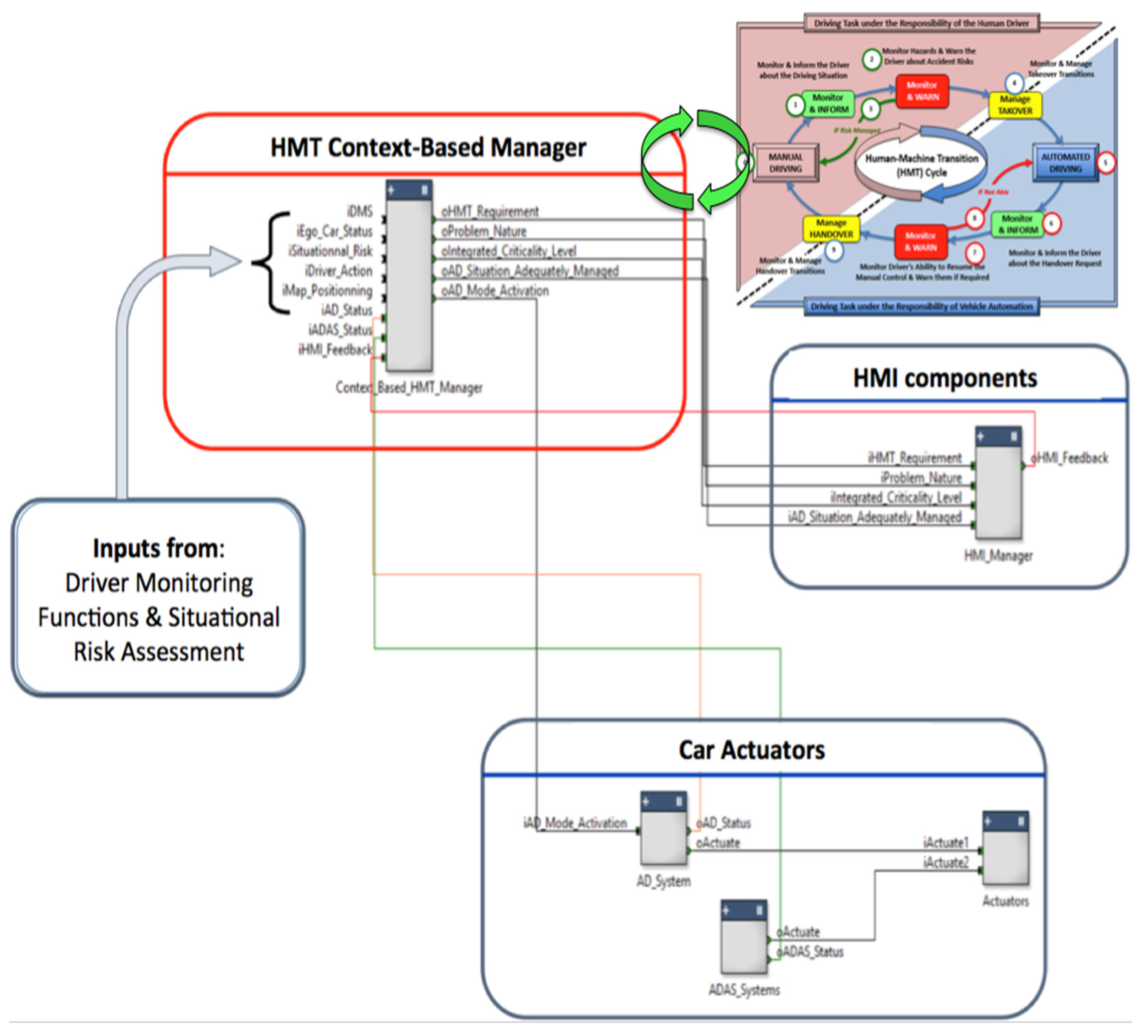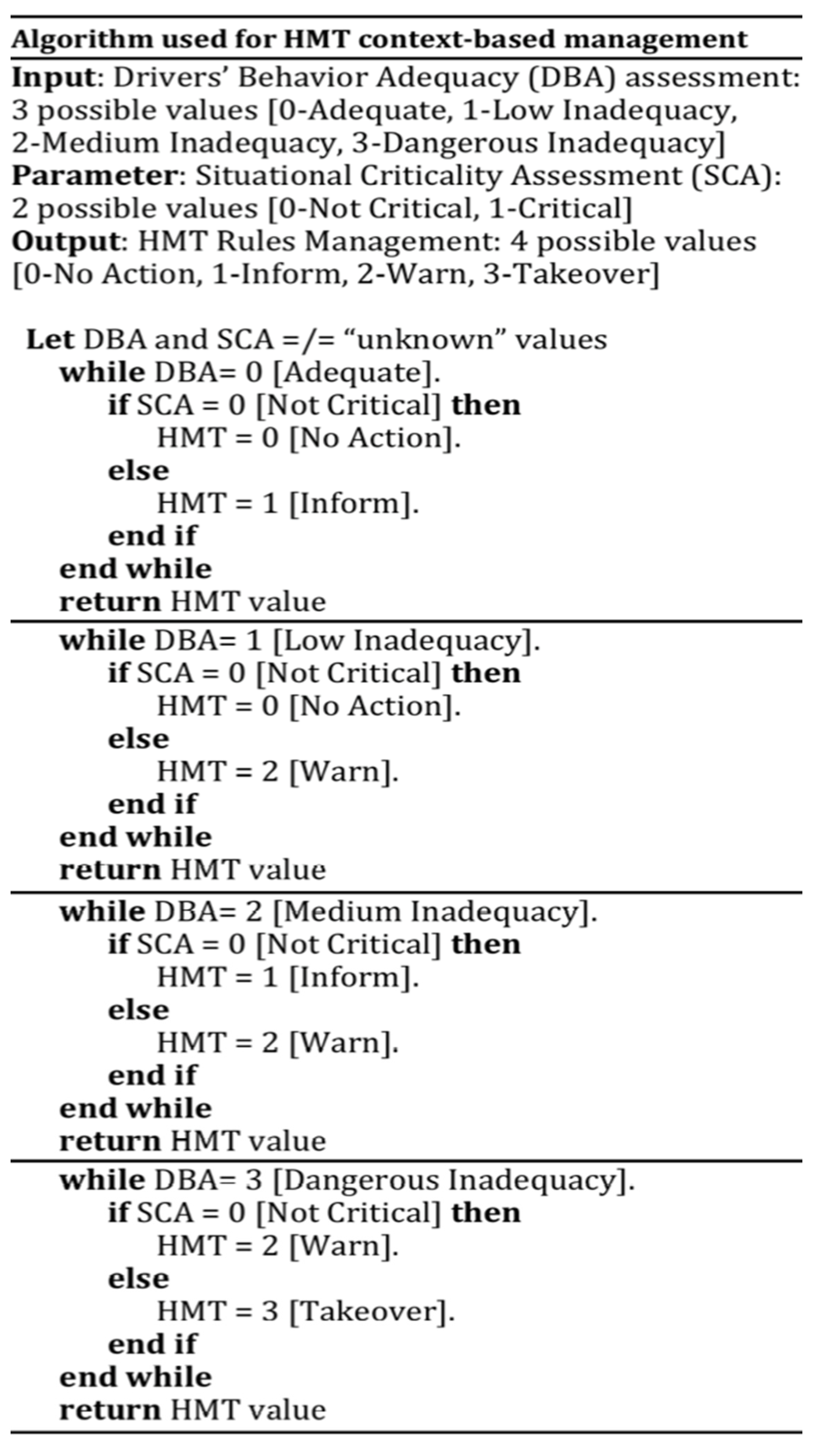Human-Centered AI to Support an Adaptive Management of Human-Machine Transitions with Vehicle Automation
Abstract
:1. Introduction
- (1)
- Theoretical foundations (Section 2.1): related to human-machine transitions in the specific area of driving assistances.
- (2)
- Ergonomics requirements (Section 2.2): towards future driving aids based-on vehicle automation, from the analysis of drivers’ errors recorded in a pre-existing naturalistic dataset.
- (3)
- Design and development of the AI algorithm (Section 3): to support the adaptive management of HMT in future vehicles.
- (4)
- Demonstrator implementation on driving simulator (Section 4): to allow future end users to practically experience interactions with this innovative solution of AI-based automation.
- (5)
- Evaluation of this AI-based solution (Section 5): from the end user’s point of view.
2. Human-Centered Design: Theoretical Foundations and Requirements towards Future Solutions of Vehicle Automation Based on AI Technics
2.1. A Theoretical Framework for Vehicle Automation: The Human-Machine Transition Cycle (HMT)
2.2. From Drivers’ Errors Analysis to Requirements for Human-Centered Vehicle Automation
3. Design and Development of an HCAI Algorithm to Support the Adaptive HMT Management
3.1. Driving Activity Modelling
3.2. HMT Context-Based Manager Development and Implementation
3.3. HCAI Algorithm to Manage HMT
4. A Human-Centered Evaluation Method
4.1. Participants
4.2. User Tests Implemented
4.3. Evaluation Process
- (1)
- The SUS questionnaire (system usability scale of Brooke [25]), composed of 10 items.
- (2)
5. Evaluation Results
5.1. HCAI Algorithm Efficiency
5.2. HCAI Algorithm Effectiveness and Impact on Users’ SATISFACTION
5.3. Usability of HCAI-Based Vehicle Automation
5.4. AttrakDiff Questionnaire Results
5.5. Effect of the User Experience on Drivers’ Intention to Use Automated Vehicles
6. Discussion of the Evaluation Results
7. Conclusions
8. Limitations
Author Contributions
Funding
Institutional Review Board Statement
Informed Consent Statement
Data Availability Statement
Conflicts of Interest
References
- Hollnagel, E.; Woods, D.D. Joint Cognitive Systems: Foundations of Cognitive Systems Engineering; CRC Press: Boca Raton, FL, USA, 2005. [Google Scholar]
- Hoc, J.-M.; Young, M.S.; Blosseville, J.-M. Cooperation between drivers and automation: Implications for safety. Theor. Issues Ergon. Sci. 2009, 10, 135–160. [Google Scholar] [CrossRef]
- Young, M.S.; Stanton, N.A.; Harris, D. Driving automation: Learning from aviation about design philosophies. Int. J. Veh. Des. 2007, 45, 323. [Google Scholar] [CrossRef] [Green Version]
- Merat, N.; Lee, J.D. Preface to the special section on human factors and automation in vehicles: Designing highly automated vehicles with the driver in mind. Hum. Factors 2012, 54, 681–686. [Google Scholar] [CrossRef] [PubMed] [Green Version]
- Kyriakidis, M.; De Winter, J.; Stanton, N.A.; Bellet, T.; Van Arem, B.; Brookhuis, K.; Martens, M.H.; Bengler, K.; Andersson, J.; Merat, N.; et al. A human factors perspective on automated driving. Theor. Issues Ergon. Sci. 2017, 20, 223–249. [Google Scholar] [CrossRef]
- Davis, F.D. A Technology Acceptance Model for Empirically Testing New End-User Information Systems: Theory and Results. Ph.D. Thesis, Massachusetts Institute of Technology, Cambridge, MA, USA, 1986. [Google Scholar]
- Venkatesh, V.; Morris, M.G.; Davis, G.B.; Davis, F.D. User acceptance of information technology: Toward a unified view. MIS Q. 2003, 27, 425–478. [Google Scholar] [CrossRef] [Green Version]
- Madigan, R.; Louw, T.; Dziennus, M.; Graindorge, T.; Ortega, E.; Graindorge, M.; Merat, N. Acceptance of Automated Road Transport Systems (ARTS): An Adaptation of the UTAUT Model. Transp. Res. Procedia 2016, 14, 2217–2226. [Google Scholar] [CrossRef] [Green Version]
- Bellet, T.; Hoc, J.M.; Boverie, S.; Boy, G.A. From human-machine interaction to cooperation: Towards the integrated co-pilot. In Human-Computer Interaction in Transport; Kolski, C., Ed.; Ashgate: Farnham, UK, 2011; pp. 129–156. [Google Scholar]
- Bellet, T.; Cunneen, M.; Mullins, M.; Murphy, F.; Pütz, F.; Spickermann, F.; Braendle, C.; Baumann, M.F. From semi to fully autonomous vehicles: New emerging risks and ethico-legal challenges for human-machine interactions. Transp. Res. Part F Traffic Psychol. Behav. 2019, 63, 153–164. [Google Scholar] [CrossRef]
- Taxonomy and Definitions for Terms Related to on-Road Motor Vehicle Automated Driving Systems. 2014. Available online: https://www.sae.org/standards/content/j3016_201806/ (accessed on 30 December 2020).
- De Raedt, R.; Ponjaert-Kristoffersen, I. Predicting at-fault car accidents of older drivers. Accid. Anal. Prev. 2001, 33, 809–819. [Google Scholar] [CrossRef]
- Lyman, S.; Ferguson, S.A.; Braver, E.R.; Williams, A.F. Older driver involvements in police reported crashes and fatal crashes: Trends and projections. Inj. Prev. 2002, 8, 116–120. [Google Scholar] [CrossRef] [Green Version]
- Clarke, D.D.; Ward, P.; Bartle, C.; Truman, W. Older drivers’ road traffic crashes in the UK. Accid. Anal. Prev. 2010, 42, 1018–1024. [Google Scholar] [CrossRef]
- Freeman, J.; Scott-Parker, B.; Wong, I.; Haworth, N. Vulnerable road user groups: A review of younger drivers, motorcyclists and older drivers. Vulnerable Groups Incl. 2012, 3. [Google Scholar] [CrossRef] [Green Version]
- Bellet, T.; Paris, J.-C.; Marin-Lamellet, C. Difficulties experienced by older drivers during their regular driving and their expectations towards Advanced Driving Aid Systems and vehicle automation. Transp. Res. Part F Traffic Psychol. Behav. 2018, 52, 138–163. [Google Scholar] [CrossRef]
- Sagberg, F.; Bjørnskau, T. Hazard perception and driving experience among novice drivers. Accid. Anal. Prev. 2006, 38, 407–414. [Google Scholar] [CrossRef] [PubMed]
- DeLucia, P.R.; Bleckley, M.K.; Meyer, L.E.; Bush, J.M. Judgments about collision in younger and older drivers. Transp. Res. Part F: Traffic Psychol. Behav. 2003, 6, 63–80. [Google Scholar] [CrossRef]
- Underwood, G.E. Visual attention on the transition from novice to advanced driver. Ergonomics 2007, 50, 1235–1249. [Google Scholar] [CrossRef]
- Bellet, T.; Bailly-Asuni, B.; Mayenobe, P.; Banet, A. A theoretical and methodological framework for studying and modelling drivers’ mental representations. Saf. Sci. 2009, 47, 1205–1221. [Google Scholar] [CrossRef]
- Paris, J.C.; Bellet, T.; Marin-Lamellet, C.; Cour, M.; Boverie, S.; Claverie, B. Assistance aux Conducteurs âgés: Analyse de l’activité pour la Conception de Futures Fonctions de Monitorage de la Conduite Automobile. 2014, pp. 227–243. Available online: https://hal.archives-ouvertes.fr/hal-01326509/document (accessed on 30 December 2020).
- Georgeon, O.L.; Mille, A.; Bellet, T.; Mathern, B.; Ritter, F.E. Supporting activity modelling from activity traces. Expert Syst. 2011, 29, 261–275. [Google Scholar] [CrossRef] [Green Version]
- Bellet, T.; Deniel, J.; Bornard, J.C.; Richard, B. Driver Modeling and Simulation to support the Virtual Human Centered Design of future Driving Aids. In Proceeding of the INCOSE International Conference on Human-Systems Integration (HSI2019), Biarritz, France, 11–13 September 2019. [Google Scholar]
- Distler, V.; Lallemand, C.; Bellet, T. Acceptability and acceptance of autonomous mobility on demand: The impact of an immersive experience. In Proceedings of the 2018 CHI Conference on Human Factors in Computing Systems, Montreal, QC, Canada, 21–26 April 2018; pp. 612–617. [Google Scholar]
- Brooke, J. SUS: A retrospective. J. Usability Stud. 2013, 8, 29–40. [Google Scholar]
- Hassenzahl, M.; Burmester, M.; Koller, F. AttrakDiff: Ein Fragebogen zur Messung wahrgenommener hedonischer und pragmatischer Qualität. In Mensch & Computer 2003. Interaktion in Bewegung; Ziegler, J., Szwillus, G., Eds.; B.G. Teubner: Stuttgart, Germany, 2003; pp. 187–196. [Google Scholar]
- Hassenzahl, M.; Monk, A. The Inference of Perceived Usability from Beauty. Human Comput. Interact. 2010, 25, 235–260. [Google Scholar] [CrossRef]
- International Organization for Standardization. ISO9241-11 Ergonomic Requirements for Office Work with Visual Display Terminals (VDTs)—Part 11: Guidance on Usability; International Organization for Standardization: London, UK, 2018. [Google Scholar]
- Bangor, A.; Kortum, P.; Miller, J.T. An Empirical Evaluation of the System Usability Scale. Int. J. Human Comput. Interact. 2008, 24, 574–594. [Google Scholar] [CrossRef]
- Logan, R.J. Behavioral and emotional usability: Thomson consumer electronics. In Usability in Practice; Academic Press Professional Inc.: Cambridge, MA, USA, 1994; pp. 59–82. [Google Scholar]
- Jordan, P.W. Designing Pleasurable Products: An Introduction to the New Human Factors; CRC Press: Boca Raton, FL, USA, 2002. [Google Scholar]
- Hassenzahl, M. The Effect of Perceived Hedonic Quality on Product Appealingness. Int. J. Human Comput. Interact. 2001, 13, 481–499. [Google Scholar] [CrossRef]
- Hassenzahl, M. User Experience (UX): Towards an Experiential Perspective on Product Quality. In Proceedings of the 20th International Conference of the Association Francophone d’Interaction Homme-Machine on—IHM ′08, Metz, France, 2–5 September 2008; pp. 11–15. [Google Scholar]
- Hassenzahl, M.; Tractinsky, N. User experience—A research agenda. Behav. Inf. Technol. 2006, 25, 91–97. [Google Scholar] [CrossRef]
- Lallemand, C.; Gronier, G. Méthodes de Design UX: 30 Méthodes Fondamentales pour Concevoir et Évaluer les Systèmes Interactifs; Editions Eyrolles: Paris, France, 2015. [Google Scholar]













| Number of Inappropriate Performance | Number of Scenarios | % of Inappropriate Performance | % of Efficient Performance | |
|---|---|---|---|---|
| AHiDA-M | 4 | 150 | 2.7% | 97.3% |
| AHiDA-A | 1 | 90 | 1.1% | 98.9% |
| AICA | 0 | 120 | 0% | 100% |
| All Systems | 5 | 360 | 1.4% | 98.6% |
| Drivers Profiles | Mean | S.D. |
|---|---|---|
| Reluctant | 81 | 18.27 |
| Neutral | 80 | 12.42 |
| Positive | 84 | 16.17 |
| All Profiles | 81.67 | 15.35 |
| Participants’ Profiles (Attitude towards Automated Vehicles) | Agreement “Before” | Agreement “After” | After versus Before “Difference” | |
|---|---|---|---|---|
| Reluctant Attitude (N = 10) | Mean | 55.1 | 79 | 23.9 |
| S.D. | 32.7 | 31.7 | 29.7 | |
| Neutral Attitude (N = 10) | Mean | 65.6 | 91 | 25.4 |
| S.D. | 30.4 | 11 | 23.2 | |
| Positive Attitude (N = 10) | Mean | 84.5 | 91 | 6.5 |
| S.D. | 16.1 | 12.9 | 10.6 | |
| All the participants (N = 30) | Mean | 68.4 | 87 | 18.6 |
| S.D. | 29.2 | 20.8 | 23.5 | |
Publisher’s Note: MDPI stays neutral with regard to jurisdictional claims in published maps and institutional affiliations. |
© 2020 by the authors. Licensee MDPI, Basel, Switzerland. This article is an open access article distributed under the terms and conditions of the Creative Commons Attribution (CC BY) license (http://creativecommons.org/licenses/by/4.0/).
Share and Cite
Bellet, T.; Banet, A.; Petiot, M.; Richard, B.; Quick, J. Human-Centered AI to Support an Adaptive Management of Human-Machine Transitions with Vehicle Automation. Information 2021, 12, 13. https://doi.org/10.3390/info12010013
Bellet T, Banet A, Petiot M, Richard B, Quick J. Human-Centered AI to Support an Adaptive Management of Human-Machine Transitions with Vehicle Automation. Information. 2021; 12(1):13. https://doi.org/10.3390/info12010013
Chicago/Turabian StyleBellet, Thierry, Aurélie Banet, Marie Petiot, Bertrand Richard, and Joshua Quick. 2021. "Human-Centered AI to Support an Adaptive Management of Human-Machine Transitions with Vehicle Automation" Information 12, no. 1: 13. https://doi.org/10.3390/info12010013




